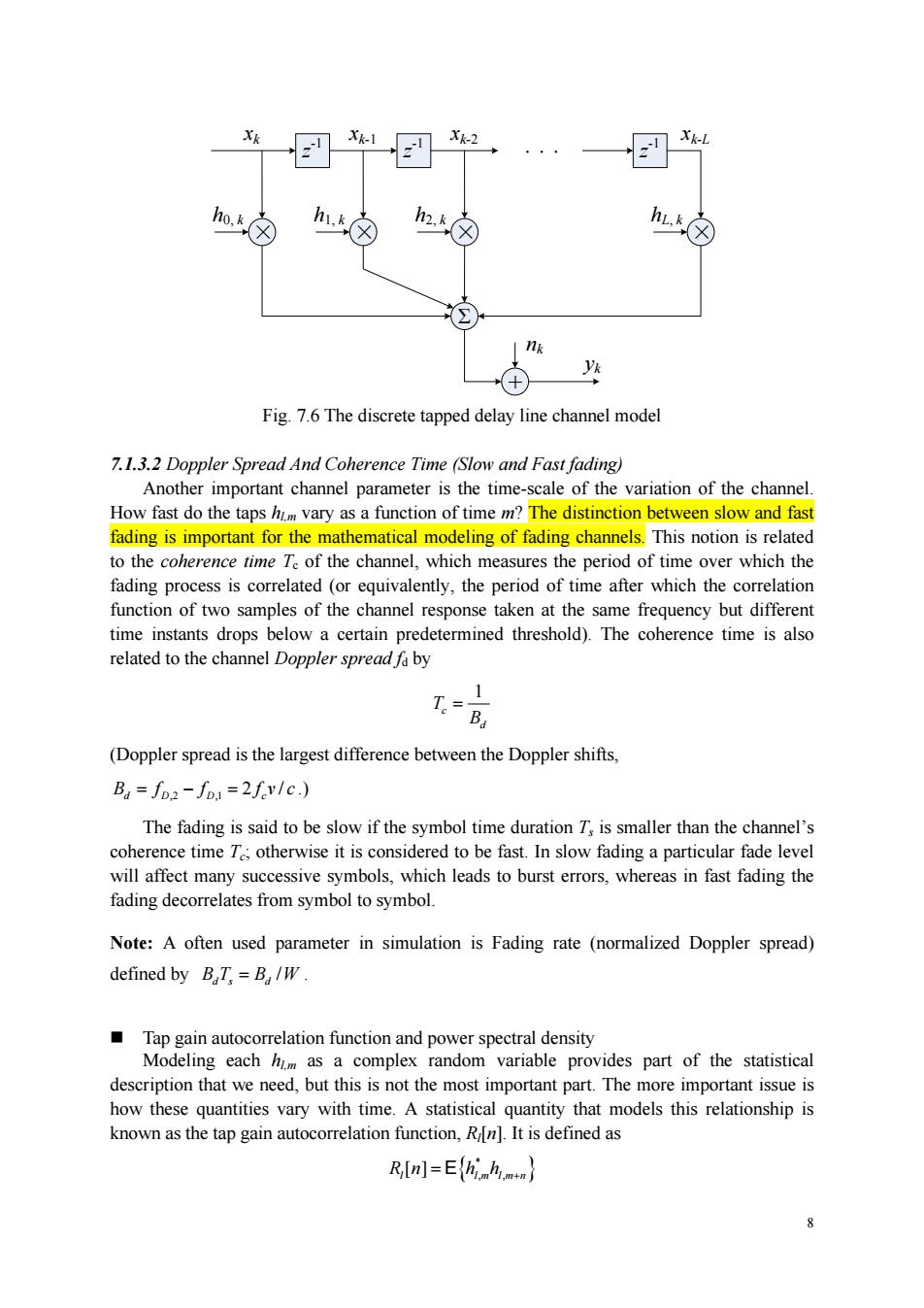正在加载图片...

ho.k交 h⊙ ② Fig.7.6The discrete tapped delay line channel model 7.1.3.2 Doppler Spread And Coherence Time(Slow and Fast fading) Another important channel parameter is the time-scale of the variation of the channel How fast do the tapshm vary as a function of time m?The distinction between slow and fast fading is mportant for the mather modeling of fading channels.This notion is related to the coherence rime Tof the channel,which measures the period of time over which the fading process is correlated (or equivalently,the period of time after which the correlation function of two samples of the channel response taken at the same frequency but different time instants drops below a certain predetermined threshold).The coherence time is also related to the channel Doppler spread faby T.Ba (Doppler spread is the largest difference between the Doppler shifts, B,=f2-f1=2fv/c.) The fading is said to be slow if the symbol time duration T,is smaller than the channel's coherence time Totherwise it is considered to be fast.In slow fading a particular fade level will affect many successive symbols,which leads to burst errors,whereas in fast fading the fading decorrelates from symbol to symbol. Note:A often used parameter in simulation is Fading rate (normalized Doppler spread) defined by BT,=B/W. orrelation function and power spectral description that we need,but this is not the most important part.The more important issue is how these quantities vary with time.A statistical quantity that models this relationship is known as the tap gain autocorrelation function,R.It is defined as RL川=Ehhn}8 z -1 z -1 z -1 × × × × Σ xk xk-1 xk-2 xk-L nk yk h0, k h1, k h2, k hL, k . . . Fig. 7.6 The discrete tapped delay line channel model 7.1.3.2 Doppler Spread And Coherence Time (Slow and Fast fading) Another important channel parameter is the time-scale of the variation of the channel. How fast do the taps hl,m vary as a function of time m? The distinction between slow and fast fading is important for the mathematical modeling of fading channels. This notion is related to the coherence time Tc of the channel, which measures the period of time over which the fading process is correlated (or equivalently, the period of time after which the correlation function of two samples of the channel response taken at the same frequency but different time instants drops below a certain predetermined threshold). The coherence time is also related to the channel Doppler spread fd by 1 c d T B (Doppler spread is the largest difference between the Doppler shifts, ,2 ,1 2 / BdD D c f f fv c .) The fading is said to be slow if the symbol time duration Ts is smaller than the channel’s coherence time Tc; otherwise it is considered to be fast. In slow fading a particular fade level will affect many successive symbols, which leads to burst errors, whereas in fast fading the fading decorrelates from symbol to symbol. Note: A often used parameter in simulation is Fading rate (normalized Doppler spread) defined by / Bds d T BW . Tap gain autocorrelation function and power spectral density Modeling each hl,m as a complex random variable provides part of the statistical description that we need, but this is not the most important part. The more important issue is how these quantities vary with time. A statistical quantity that models this relationship is known as the tap gain autocorrelation function, Rl[n]. It is defined as * , , [ ] Rn h h l lm lm n E